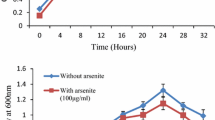Abstract
Two strains of Thiobacillus, T. ferrooxidans and T. thiooxidans, have been isolated from a bacterial inoculum cultivated during a one-year period in a 1001 continuous laboratory pilot for treatment of an arsenopyrite/pyrite concentrate. The optimum pH for the growth of both strains has been found to be between 1.7 and 2.5. Because of the high metal toxicity in bioleach pulps, the tolerance of T. ferrooxidans and T. thiooxidans with respect to iron and arsenic has been studied. The growth of both strains is inhibited with 10 g/l of ferric ion, 5 g/l of arsenite and 40 g/l of arsenate. 20 g/l of ferrous iron is toxic to T. ferrooxidans but 30 g/l is necessary to impede the growth of T. thiooxidans.
Similar content being viewed by others
References
Braddock JF, Luong HV & Brown EJ (1984) Growth Kinetics of Thiobacillus ferroxidans isolated from arsenic mine drainage. Appl. Envion. Microbiol. 48: 48–55
Charlot G (1966) Les méthodes de la chimie analytique, analyse quantitative minérale. 5th ed Masson et Cie (eds) Paris, France
Corbett CM & Ingledew W (1987) Is Fe3+/2+ cycling an intermediate in sulphur oxidation by Fe2+-grown Thiobacillus ferroxidans. FEMS Microbiol. Lett. 41: 1–6
Johnson DB, Macvicar JH M & Rolfe S (1987) A new solid medium for the isolation and enumeration of Thiobacillus ferroxidans and acidophilic heterotrophic bacteria. J. Microbiol. Meth. 7: 9–18
Karavaiko GI, Kuznetsov SI & Colonizik AI (1977) The bacterial leaching of metals from ores. English translation of ‘Izd Naud’ Moscow (1972) Technicopy Ltd Stonehouse Glos, England
Kuenen JC & Tuovinen OH (1981) The genera Thiobacillus and Thiomiscropira. In: Starr MP, Stolp H, Trüper HG, Balows A & Schlegel HG (Eds) The Procaryote (pp 1004–1048) Springer-Verlag, Berlin-Heidelberg-New York
Livesey-Goldblatt E, Norman Philippa & Livesey-Goldblatt DR (1983) Gold recovery from arsenopyrite/pyrite ore by bacterial leaching and cyanidation. In: Rossi G & Torma AE (Eds) Recent Progress in Biohydrometallurgy (pp 627–641) Associazione Mineraria Sarda, Italy
Manning HL (1975) New medium for isolating iron-oxidising and heterotrophic acidophilic bacteria from acide mine drainage. Appl. Microbiol. 30: 1010–1016
Mishra AK & Roy P (1979) A note on the growth of Thiobacillus ferroxidans on solid medium. J. Appl. Bacteriol. 47: 289–292
Morin D, Collinet MN, Ollivier P, El Kaliobi F & Livesey-Goldblatt E (1989) Etude de la lixiviation bactérienne de concentré sulfuré arsénié d'or réfractaire en pilote de laboratoire. Ind. Miné. Mines et Car. Techn. march-april 1989: 61–69
Mouraret M & Baldensperger J (1977) Use of membrane filters for the enumeration of autrophic Thiobacilli. Microbiol. Ecol. 3: 345–359
Norris PR & Kelly DP (1978) Toxic metals in leaching systems. In: Murr LE, Torma AE & Brierley JA (Eds) Metallurgical Applications of Bacterial Leaching and Related Microbiological Phenomena (pp 83–102) Academic Press, New York
Panin VV, Karavaiko GI & Pol'kin SI (1985) Mechanisms and kinetics of bacterial oxidation of sulphide minerals. In: Karavaiko GI & Groudev SN (Eds) Biotechnology of Metals Proceedings of International Seminar and International Training Course Centre of International Projects (pp 197–215) GKNT Moscow, USSR
Silverman MP & Lundgren DC (1959) Studies on the chemoautotrophic-iron bacterial F. ferroxidans: I. An improved medium and a harvesting procedure for securing high cell yields. J. Bacteriol. 77: 642–647
Sugio T, Katagiri T, Mokiyama M, Zhen YL, Inagaki K & Tano T (1988) Existence of a new type of sulfite oxydase which utilizes ferric ions as electron acceptor in Thiobacillus ferroxidans. Appl. Environ. Microbiol. 54: 153–157
Torma AE (1988) Use of biotechnology in mining and metallurgy. Biotech. Adv. 16: 1–83
Tuovinen OH & Kelly DP (1974) Studies of the growth of Thiobacillus ferroxidans V: Factors affecting growth in liquid culture and development of colonies on solid media containing inorganic sulphur compounds. Arch. Microbiol. 98: 351–364
Tuovinen OH, Niemela SI & Gyllenberg HG (1971) Tolerance of Thiobacillus ferroxidans to some metals. Anton. Leeuwenhoek 37: 489–496
Waksman SA & Joffe IS (1922) Microorganisms concerned with the oxidation of sulfur in soil II: Th. Thiooxidans a new sulfur oxidizing organism isolated from the soil. J. Bacteriol. 7: 239
Author information
Authors and Affiliations
Rights and permissions
About this article
Cite this article
Collinet, MN., Morin, D. Characterization of arsenopyrite oxidizing Thiobacillus. Tolerance to arsenite, arsenate, ferrous and ferric iron. Antonie van Leeuwenhoek 57, 237–244 (1990). https://doi.org/10.1007/BF00400155
Received:
Accepted:
Issue Date:
DOI: https://doi.org/10.1007/BF00400155




